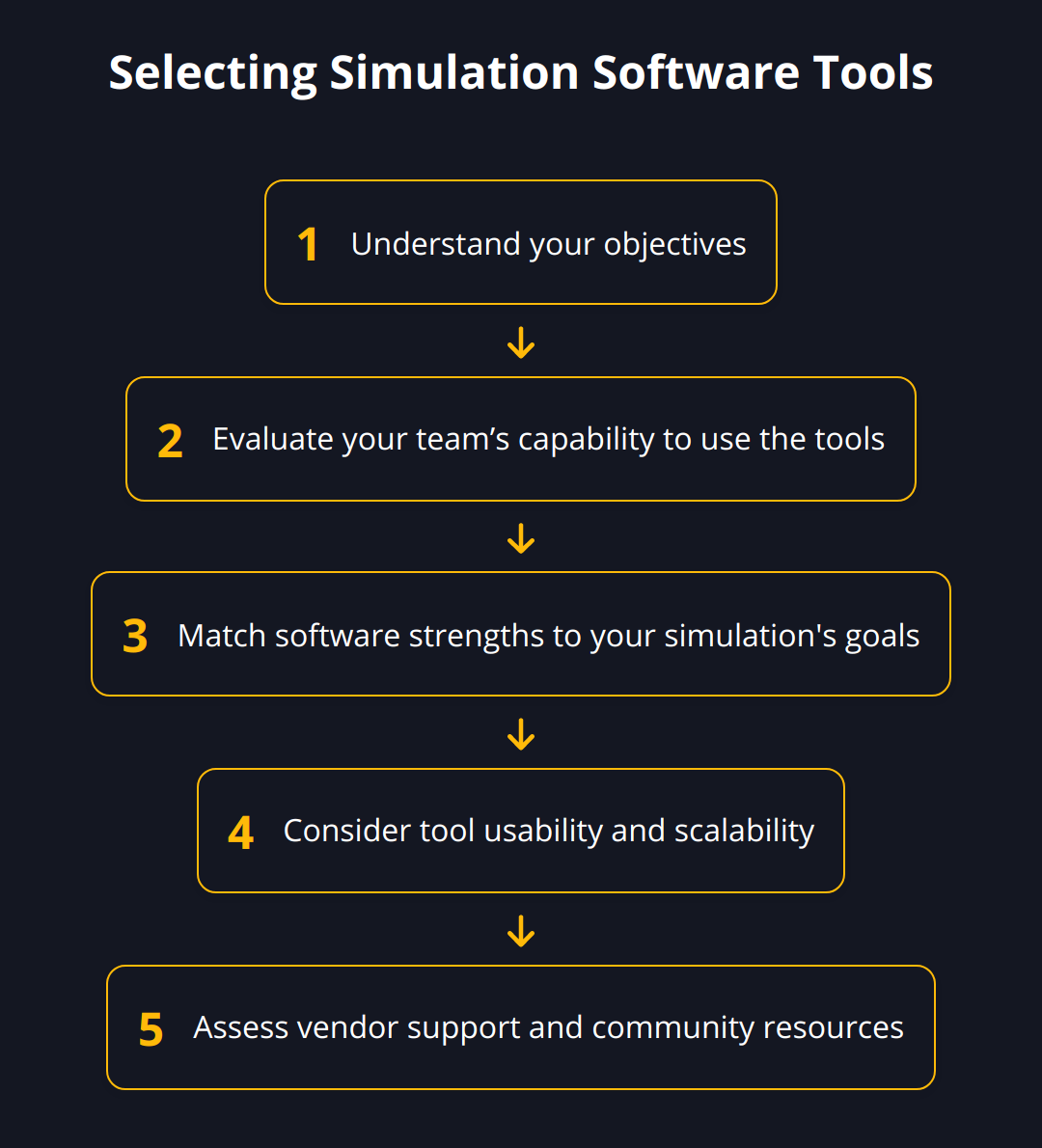Industrial simulation models are pivotal tools that allow businesses to anticipate outcomes, optimize processes, and make informed decisions. They are rooted in data and demand an intricate understanding of the specific industrial landscape.
We at Newroom Connect understand their significance and the need for precise and practical guidance on their deployment. This post will unravel the essential best practices for developing and utilizing industrial simulation models effectively, ensuring your team is well-equipped to harness their full potential.
Industrial Simulation Essentials
Industrial simulations are powerful analysis and forecasting tools, integral for industries to stay agile in a rapidly evolving market. When industries apply simulation models, they are essentially creating a dynamic virtual representation of their systems which enables them to predict outcomes and fine-tune processes without the cost or risk of real-world trial and error.
Specific types of industrial simulations include Discrete-Event Simulation (DES), Agent-Based Simulation (ABS), and Monte Carlo Simulation (MCS), each suited to varied aspects such as timing of processes, individual agent behaviors, and risk analysis, respectively. For instance, DES is often the go-to choice for optimizing manufacturing lines, where the timing of events is critical. Conversely, ABS can provide deeper insights into consumer behavior in a retail environment, and MCS might be pivotal in financial forecasting where uncertainty is a factor.

The value of simulations in decision-making can hardly be overstated. They offer a robust foundation for strategic planning, allowing companies to test scenarios and potential changes ahead of implementation. For example, data from simulations can inform the upgrade of machinery, the rearrangement of production lines, or the potential benefits of adopting new technologies.
Simulations have concrete applications across sectors. The manufacturing industry utilizes them to predict production bottlenecks and to optimize supply chain logistics. Healthcare industries employ simulations to forecast patient flows and resource allocation in hospitals. Meanwhile, urban planners simulate traffic patterns to design more efficient road layouts. Trends in the adoption of simulations are compelling, with the global market for simulation software in manufacturing projected to hit nearly $20 billion by 2025.

Here are a few key points to ensure simulations are yielding practical advantages:
-
Always start with a clear goal: Determine exactly what you want to achieve with simulations.
-
Keep it simple yet sufficient: The model should be detailed enough to provide insights but not so complex that it becomes unmanageable.
-
Data quality is paramount: Ensure your model is fed with accurate and relevant data.
-
Test and iterate: Use simulations to test multiple scenarios and refine your approach based on the results.
-
Continuously update your model: As real-world situations and data change, so should your model.
One must not underestimate the role of reliable simulation models in maintaining a competitive edge in today’s market. If you’re involved in designing digital twin technologies for your manufacturing workflows, diving into our insights on digital twins in manufacturing can showcase the interconnectedness of simulation models and advanced manufacturing practices. Moreover, understanding the latest e-learning platform trends can help in developing simulation training modules for industry professionals, further highlighting the practical applications of simulation models across different domains.
Industrial simulations are not just about forecasting and optimization; they also play a significant role in training personnel, reducing risk, and scaling up production—all of which have a direct impact on the bottom line. By integrating these best practices, industries can invest wisely in simulation models, leading to greater innovation, efficiency, and productivity advancements.
Crafting Robust Industrial Simulations
Developing effective industrial simulation models is a vital step for any business looking to improve decision-making and optimize processes. In this pursuit, practicality is key—models must be rooted in real-world data and objectives.
Identifying Key Objectives and Metrics
Clear objectives are the lighthouse that guides the entire simulation process. Without them, efforts can quickly run off course. Begin by defining what success looks like for your project. For instance, are you looking to reduce production time, enhance product quality, or streamline resource allocation? Once you’ve pinpointed the end goal, you can select metrics that appropriately measure these outcomes—such as production yield, defect rates, or inventory turnover.

Concrete metrics enable an objective evaluation of simulation performance. They also facilitate vital comparisons, such as before-and-after scenario analyses. For example, a packaging company that wishes to minimize downtime might track the Mean Time Between Failures (MTBF) for their machinery. If a simulation suggests changes that increase MTBF, that’s a clear indicator of potential real-world improvements.
Gathering Accurate and Comprehensive Data
Garbage in, garbage out – this is a stern reality in simulation modeling. The accuracy of the data you input directly correlates with the reliability of the outcomes. Therefore, businesses must dedicate resources to acquire precise data, which is often a blend of historical performance figures, real-time feed from sensors, and qualitative inputs from experienced employees.
In data gathering, there’s also a delicate balance to strike. While you need detailed data to create nuanced simulations, overloading your model with every conceivable variable can lead to bloated and unmanageable simulations. Prioritize data that most closely aligns with your objectives and metrics, and make sure to validate its accuracy.
Numbers from the shop floor might tell you that Machine A has an output of 100 units per hour, but it’s essential to verify these figures through observations or more advanced data collection techniques. Moreover, qualitative data, such as expert reviews, can reveal nuances that pure quantitative data may miss.
Using Appropriate Simulation Software Tools
The simulation software market is diverse, with applications that cater to numerous industry sectors and technical requirements. Selecting the right software for your needs is critical. It requires a clear understanding of your objectives and the capability of your team to operate complex simulation tools.
Some tools are specialized for certain types of simulations. For example, DES software may be best suited for streamlining a manufacturing process, while a Finite Element Analysis (FEA) tool would be the choice for stress testing a new product design. It is important to match your chosen software’s strengths to your simulation’s goals.

Remember, an advanced tool is not necessarily better. Software that your team cannot fully leverage due to its complexity or learning curve can do more harm than good. Opt for a balance between functionality and user-friendliness, ensuring that the tool scales with your needs as you grow.
In selecting software, also consider the long-term—will the vendor provide good support? Are there training materials or community forums available to help your team learn and troubleshoot issues? This support can be pivotal for successful simulation endeavors.
Lastly, the implementation of these models must be handled with care. Testing and continuous improvement are critical, as your first simulation run is unlikely to be perfect. Encourage feedback from diverse stakeholders, iterate on the model, and always align improvements with the overall strategic objectives of your business.
In summary, effective simulations are built on clear goals, quality data, and the judicious selection of software tools. By adhering to these best practices, your simulation models can offer insightful projections that guide smarter business decisions. With the next phase of the project on the horizon, your groundwork in creating these simulations will provide a sturdy foundation for further advancements and refinements.
Running Effective Simulations
The true power of industrial simulations lies not in their construction but in their execution. Optimal performance emerges from rigorous testing, vigilant model iteration, and competent team training. Here we zero in on actionable approaches that elevate your simulation practices.
Testing and validation go hand in hand for industrial simulation models. It’s not enough to develop a model; you need to expose it to extreme conditions to confirm its resilience. This means stress-testing your model with various input combinations, even those that seem unlikely in the real world. Unearth any weaknesses before they can cause real-world repercussions is a smart move. A simulation predicting the failure points of a bridge should withstand mock scenarios of extreme weather or unusually heavy traffic loads, for instance.
The nuance of validation cannot be overlooked. It’s about ensuring your model reflects real-life with as much accuracy as possible. That’s where the numbers speak louder than words. If you’re validating a process simulation, compare the model’s predictions against historical data. A tight correlation between model forecasts and actual data is a strong indicator of validity. It is worth reading about validation techniques to gain insights into this critical aspect of simulation modeling.
Iterative improvement is the hallmark of an evolving model. Rarely does a model reach perfection in its maiden voyage. Refinement is the key. After initial testing, gather cross-departmental feedback. Finance may see cost efficiencies engineering missed, or floor managers might highlight practicality issues. With each iteration, enhance accuracy and functionality based on this feedback loop. Remember, a model too rigid to adapt is destined to fail in an ever-shifting industrial landscape.
Training teams to effectively use simulation models does not stop at operation proficiency. Teams must understand the underlying principles, objectives, and the strategic value the model brings to the table. Organizing workshops or engaging in e-learning modules on simulations are sound strategies to build this comprehension. One cannot underscore enough the treasures buried in know-how; it is the linchpin of model utility. Engage with resources like e-learning strategies to discover methods for upskilling teams effectively.

Adopting these actionable approaches will undoubtedly enhance your simulations, yielding models that are not only predictive but also prescriptive, forward-looking tools that advise on the best course of action for your business. Keep these points in mind:
-
Verify your simulations against varied and extreme data sets.
-
Validate your model with historical data and seek high correlation for credibility.
-
Iterate and refine models using diverse feedback to ensure comprehensive accuracy.
-
Invest in up-to-date training for your teams to maximize the model’s potential in your operational context.
Advance through these practices systematically, and your simulations will become indispensable instruments in your industrial toolset. Watch as your decisions become more confident and your processes more refined, all rooted in the solid ground of practical, proven simulation models. The next chapter will further explore how to translate these refined models into tangible business value, integrating them into your daily operations for maximal impact.
Final Thoughts
As we wrap up our conversation on industrial simulation models, it’s important to distill the best practices that will propel businesses to harness simulations with precision and effectiveness. Clear goals, meticulous data collection, appropriate software tools, and robust testing are not just isolated steps but form a cohesive roadmap to successful simulation implementations.

Looking ahead, we can anticipate further advancements in simulation technology, with increasing integration of machine learning algorithms and real-time data analytics. These advancements will refine the accuracy and predictive power of industrial simulations, making real-time decision-making more informed than ever before.
Continuous improvement and learning are vital in keeping pace with this technological evolution. Businesses should foster a culture of perpetual learning to stay ahead. This includes not just technical training but also strategic thinking on how to incorporate emerging trends into business models.
At Newroom Connect, we are dedicated to empowering businesses with cutting-edge virtual tools. Given the potential for robust simulations to serve as training grounds, consider exploring our platform for creating immersive e-learning environments. Embrace our tools to stay competitive in an ever-advancing industrial landscape.
Key takeaways for businesses looking to excel in simulation modeling:
-
Set clear goals and identify relevant metrics
-
Prioritize high-quality data
-
Choose the right software
-
Commit to ongoing testing and iteration
-
Invest in team training to maximize potential
Industries equipped with sophisticated simulation models can witness significant strategic advantages—enhanced efficiency, lower operational risks, and sharpened competitive edge. By understanding and implementing the foundations shared here, businesses are well on their way to realizing these benefits.
Embrace these insights and transform your business’s approach to simulations and data-driven strategy. As simulations evolve, keep the cycle of improvement moving—explore, adjust, and evolve. This is how we at Newroom Connect envision fostering a future of unparalleled industrial innovation and growth.


